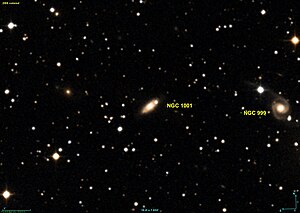NGC 1001
| Galaxy NGC 1001 |
|
|---|---|

|
|
| AladinLite | |
| Constellation | Perseus |
|
Position equinox : J2000.0 , epoch : J2000.0 |
|
| Right ascension | 02 h 39 m 12.6 s |
| declination | + 41 ° 40 ′ 18 ″ |
| Appearance | |
| Morphological type | Sbc |
| Brightness (visual) | 14.8 mag |
| Brightness (B-band) | 15.6 mag |
| Angular expansion | 0.7 '× 0.3' |
| Position angle | 132 ° |
| Surface brightness | 13.0 mag / arcmin² |
| Physical data | |
| Redshift | 0.015537 +/- 0.000113 |
| Radial velocity | 4658 +/- 34 km / s |
|
Stroke distance v rad / H 0 |
(214 ± 15) · 10 6 ly (65.5 ± 4.6) Mpc |
| history | |
| discovery | Édouard Stephan |
| Discovery date | December 8, 1871 |
| Catalog names | |
| NGC 1001 • PGC 10050 • CGCG 539-069 • KUG + 07-06-050 • 2MASX J02391263 + 4140182 • LDCE 224 NED051 | |
NGC 1001 is a spiral galaxy of Hubble type Sbc in the constellation Perseus in the northern sky . It is an estimated 214 million light years away from the Milky Way and has a diameter of about 45,000 ly.
In the same area of the sky are the galaxies NGC 995 , NGC 996 , NGC 999 , NGC 1005 .
The object was discovered on December 8, 1871 by Édouard Stephan .
